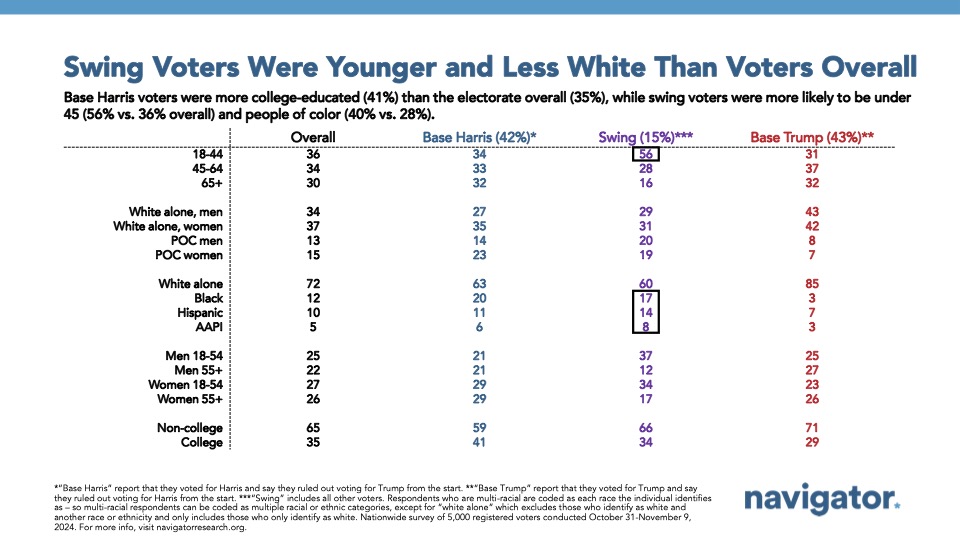Exit Poll: Swing Voters
This Navigator Research report is the first in a series of releases of findings from our post-election survey among 5,000 self-reported 2024 general election voters. This release focuses on the key voting blocks that delivered Donald Trump’s presidential election victory, as well as perceptions of both Kamala Harris and Trump, and how Americans assess the national landscape compared to that of 2020.
Donald Trump won the presidential election in large part by winning “swing voters.”
“Swing voters” — defined here as those who did not rule out voting for Donald Trump or Kamala Harris from the start of the campaign — largely delivered Trump’s victory, voting for the former president by 8 points. 41 percent of “swing voters” supported Donald Trump and 33 percent supported Kamala Harris, with the remainder voting for third-party candidates (22 percent) or skipping the presidential election on their ballot (4 percent). While their vote in the presidential election leaned Republican, swing voters were split in Senate races (44 percent Democratic candidate – 44 percent Republican candidate) and House races (45 percent Democratic candidate – 45 percent Republican candidate), and broke narrowly for Democratic candidates in gubernatorial races by 4 points (45 percent Democratic candidate – 41 percent Republican candidate).
- “Swing voters” were a group significantly younger and more racially diverse than the electorate overall. A majority of swing voters were under the age of 45 (56 percent), 20 points greater than the share of all 2024 voters (36 percent). Moreover, 17 percent of “swing voters” were Black (compared to 12 percent of the overall electorate), 14 percent were Hispanic (compared to 10 percent overall), and 8 percent were Asian Americans and Pacific Islanders (8 percent, compared to 5 percent overall).
- While “swing voters” helped Trump carve a path to victory, he was also able to assemble a coalition of base Trump voters (38 percent of the electorate) along with a combination of first-time Trump voters and 2020 Trump voters who at least considered Harris in 2024 (11 percent of the electorate). This group was similarly overwhelmingly younger, with 55 percent under the age of 45 (compared to 36 percent overall), and in particular driven by younger men, who were 42 percent of these voters (compared to 25 percent of the overall electorate).
Both candidates went into election night with slightly underwater favorability ratings, including among “swing voters.”
Kamala Harris went into the presidential election with a favorability rating that was 5 points underwater among the 2024 electorate (47 percent favorable – 52 percent unfavorable) while Donald Trump went into the election with a net favorability rating underwater by 6 points (47 percent favorable – 53 percent unfavorable). Among “swing voters,” Harris’ favorability rating was slightly more underwater (net -10; 43 percent favorable – 53 percent unfavorable) than Trump’s (net -7; 46 percent favorable – 53 percent unfavorable). Similarly among “swing voters,” the Democratic Party’s net favorability was 12 points underwater (42 percent favorable – 54 percent unfavorable), while the Republican Party’s net favorability was closer to even at just 4 points underwater (45 percent favorable – 49 percent unfavorable).
- Though Trump’s net negative favorability rating was underwater among “swing voters” by 7 points, nearly three in five of these voters retrospectively approved of Trump’s job handling during his first term as president (59 percent approve – 37 percent disapprove).
Perceptions of the economy were a decisive factor for Trump winning swing voters in the election.
Three in four “swing voters” had negative views of the direction of the country and the economy, and disapproved of Biden’s handling of the economy going into election night. Seven in ten voters had negative views of the national economy (70 percent), including three in four “swing voters” (76 percent). Similar majorities of the overall electorate believed the country was off on the wrong track (63 percent), including 63 percent of swing voters — an almost identical margin to where it was at the time of the 2020 presidential election when Biden defeated Trump. At the same time, President Biden held job approval ratings that were below 40 percent in terms of his overall job performance (net -22; 38 percent approve – 60 percent disapprove) and when it came to handling the economy (net -24; 37 percent approve – 61 percent disapprove). Among “swing voters,” Biden’s disapproval rating rose to seven in ten among this group (net -46; 25 percent approve – 71 percent disapprove).
- Nearly three in five “swing voters” reported experiencing personal financial hardship: a majority (57 percent) said they were making ends meet, but just barely (43 percent) or were not making ends meet (14 percent). Just 28 percent who said they were comfortably making ends meet and 15 percent saying they were having no trouble making ends meet.
About The Study
Global Strategy Group conducted an online survey of 5,000 registered voters from October 31st through November 9th, 2024, with respondents recruited from opt-in online panel vendors. Of that 5,000, 4,784 respondents were verified against a voter file (and the other 216 were voters who said they were registering before voting if interviewed before Election Day) and special care was taken to ensure the demographic composition of the sample reflected that of the expected 2024 electorate. The vote shares for Kamala Harris, Donald Trump, House and Senate Democrats, and House and Senate Republicans were also adjusted to reflect a preliminary estimate of the vote in the 2024 election. The margin of error for the full sample at the 95 percent level of confidence is +/- 1.4 percentage points. The margin of error for subgroups varies and is higher.












